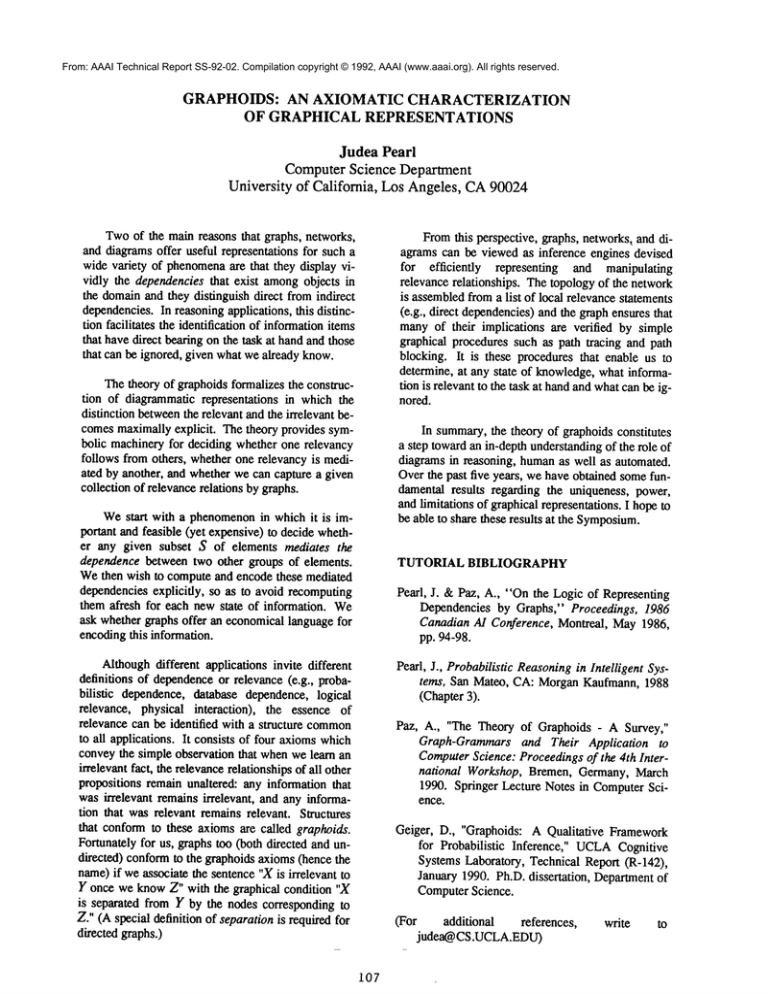
From: AAAI Technical Report SS-92-02. Compilation copyright © 1992, AAAI (www.aaai.org). All rights reserved.
GRAPHOIDS:
OF
AN AXIOMATIC
CHARACTERIZATION
GRAPHICAL
REPRESENTATIONS
Judea Pearl
Computer Science Department
University of California,
Los Angeles,
Twoof the main reasons that graphs, networks,
and diagrams offer useful representations for such a
wide variety of phenomenaare that they display vividly the dependencies that exist amongobjects in
the domainand they distinguish direct from indirect
dependencies.In reasoning applications, this distinction facilitates the identification of informationitems
that have direct bearing on the task at hand and those
that can be ignored, given what we already know.
CA 90024
Fromthis perspective, graphs, networks, and diagrams can be viewed as inference engines devised
for efficiently
representing and manipulating
relevance relationships. The topology of the network
is assembledfrom a list of local relevance statements
(e.g., direct dependencies)and the graph ensures that
manyof their implications are verified by simple
graphical procedures such as path tracing and path
blocking. It is these procedures that enable us to
determine, at any state of knowledge, what information is relevant to the task at handand whatcan be ignored.
The theory of graphoids formalizes the construction of diagrammatic representations in which the
distinction betweenthe relevant and the irrelevant becomes maximally explicit. The theory provides symbolic machinery for deciding whether one relevancy
follows from others, whether one relevancy is mediated by another, and whether we can capture a given
collection of relevance relations by graphs.
In summary,the theory of graphoids constitutes
a step towardan in-depth understanding of the role of
diagrams in reasoning, humanas well as automated.
Over the past five years, we have obtained somefundamental results regarding the uniqueness, power,
and limitations of graphical representations. I hopeto
be able to share these results at the Symposium.
Westart with a phenomenonin which it is important and feasible (yet expensive) to decide whether any given subset S of elements mediates the
dependence between two other groups of elements.
Wethen wish to compute and encode these mediated
dependencies explicitly, so as to avoid recomputing
them afresh for each new state of information. We
ask whether graphs offer an economical language for
encodingthis information.
TUTORIAL BIBLIOGRAPHY
Pearl, J. & Paz, A., "On the Logic of Representing
Dependencies by Graphs," Proceedings, 1986
Canadian AI Conference, Montreal, May1986,
pp. 94-98.
Althoughdifferent applications invite different
definitions of dependenceor relevance (e.g., probabilistic dependence, database dependence, logical
relevance, physical interaction),
the essence of
relevance can be identified with a structure common
to all applications. It consists of four axiomswhich
convey the simple observation that whenwe learn an
irrelevant fact, the relevance relationships of all other
propositions remain unaltered: any information that
was irrelevant remains irrelevant, and any information that was relevant remains relevant. Su’uctures
that conformto these axioms are called graphoids.
Fortunately for us, graphs too (both directed and undirected) conformto the graphoids axioms (hence the
name)if we associate the sentence "X is irrelevant to
Y once we knowZ" with the graphical condition "X
is separated from Y by the nodes corresponding to
Z." (A special definition of separation is required for
directed graphs.)
107
Pearl, J., Probabilistic Reasoningin Intelligent Systems, San Mateo, CA: Morgan Kaufmann, 1988
(Chapter 3).
Paz, A., "The Theory of Graphoids - A Survey,"
Graph-Grammars and Their Application to
ComputerScience: Proceedings of the 4th International Workshop, Bremen, Germany, March
1990. Springer Lecture Notes in ComputerScience.
Geiger, D., "Graphoids: A Qualitative Framework
for Probabilistic Inference," UCLACognitive
Systems Laboratory, Technical Report (R-142),
January 1990. Ph.D. dissertation, Deparlmentof
ComputerScience.
(For
additional
references,
judea@CS.UCLA.EDU)
write
to



